Thank you for visiting! By the way… any links on this page that lead to products on Amazon and other stores/partners are affiliate links Aquarium Store Depot earns a commission if you make a purchase.
Are you looking for the perfect fish species for your freshwater aquarium? Choosing the right fish can be loads of fun, but also pretty hard work – there are over ten thousand species out there!
In this blog post, we’ll be checking out 30 of the best freshwater aquarium fish species in the world and hopefully, you’ll find what you’re looking for.
Let’s dive right in!
Key Takeaways
- Keep schooling fish like tetras, barbs, and danios in groups of at least 6. They will be much more lively and confident that way.
- Avoid large, aggressive fish if you’re new to keeping fish. There are many amazing beginner fish species to choose from!
- Research the needs of your fish carefully. Each species has its own tank, water, and diet requirements.
- Provide your fish with the best care you can. They will reward you with many years of joy and entertainment!
30 Of The Best Freshwater Aquarium Fish
Have you ever walked into a fish store and been overwhelmed by the variety of beautiful fish species swimming around in their tanks? It happens to all of us, and it can make choosing the right fish quite a challenge.
However, if you’re reading this post, you’re on the right track! Learning the key facts about each fish is so important before having it netted and bagged. The 30 fish types in this post are all very different, so pay attention to these facts when making your choice:
- Scientific Name
- Care Level
- Temperament
- Swimming Level
- Origin
- Adult Size
- Minimum Tank Size
- Water Temperature
- pH
We got a video below from our YouTube channel you can follow along. We go over more detail in our blog post so enjoy looking at both. If you like our content, be sure to subscribe as post new videos weekly!
Now, for the fun part, let’s meet some amazing fish!
1. Betta
Use Coupon Code ASDFISH at Checkout
Betta Fish are one of the most beautiful varieties of freshwater fish available in the hobby. Easy to care for with plenty of varieties!
- Scientific Name: Betta Splendens
- Care Level: Easy
- Temperament: Aggressive
- Swimming Level: All levels
- Origin: Thailand
- Adult Size: 2.5 – 3 inches
- Minimum Tank Size: 5 gallons
- Water Temperature: 76 – 82°F
- pH: 6.5 – 8
The betta fish is one of the all-time greatest freshwater aquarium fish species. These fish have amazing colors and the most beautiful fins to match.
They make great pet fish for first-time fishkeepers and the best part is you can keep one in a tank of just 5 gallons or more. The male fish are very aggressive towards other betta fish, so you should never keep more than one in the same tank.
2. Angelfish
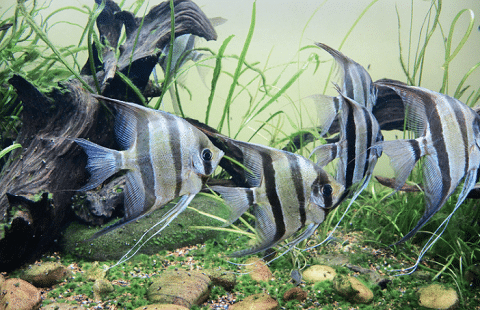
- Scientific Name: Pterophyllum scalare
- Care Level: Easy
- Temperament: Peaceful
- Swimming Level: Middle/top
- Origin: South America
- Adult Size: 6 inches
- Minimum Tank Size: 30 gallons
- Water Temperature: 78 – 84°F
- pH: 6.8 – 7.8
Freshwater angelfish are tropical fish from the cichlid family. These unique freshwater aquarium fish have huge fins on their belly and their back, often making them taller than they are long!
There are many amazing types of angel fish to choose from, and they are great community fish with other peaceful species like tetras and cory catfish.
3. Goldfish
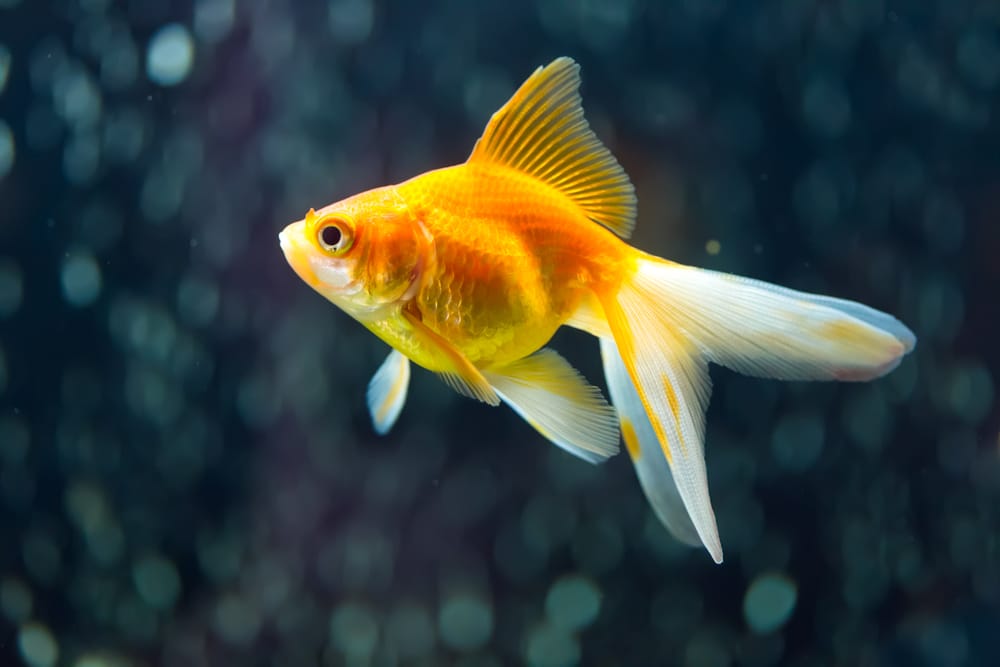
- Scientific Name: Carassius auratus
- Care Level: Intermediate
- Temperament: Peaceful
- Swimming Level: All Levels
- Origin: East Asia
- Adult Size: 6-12 inches
- Minimum Tank Size: 20 – 40 gallons
- Water Temperature: 65 – 72°F
- pH: 6.5 – 7.5
The goldfish is a mainstay of the aquarium hobby. These popular freshwater aquarium fish have been kept for centuries and are available in many weird and wonderful breeds.
Goldfish are not ideal fish for beginners, however. They prefer their water cool and they eat plants, so they aren’t the best choice for planted tanks or tropical fish communities.
Nevertheless, the goldfish is still one of the most beautiful freshwater fish in the world, and they make a wonderful and long-lived pet fish.
4. Discus
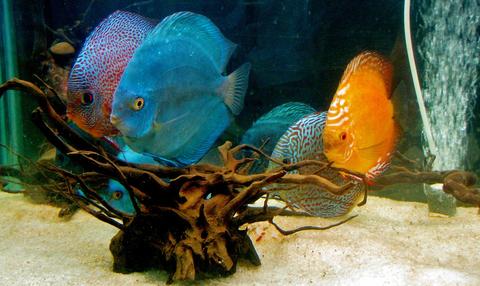
- Scientific Name: Symphysodon discus
- Care Level: Intermediate-advanced
- Temperament: Peaceful
- Swimming Level: Middle
- Origin: South America
- Adult Size: 5-8 inches
- Minimum Tank Size: 70 gallons
- Water Temperature: 82 – 86°F
- pH: 6 – 7
The discus is a truly gorgeous fish species that you just can’t walk past without admiring. These South American cichlids have some of the most incredible colors and patterns, but they are not ideal for beginner fish keepers.
Discus fish prefer warmer water than most other species, so mixing them with other fish in a community tank can be tricky. These large fish also need perfect water quality and a nice big aquarium to stay healthy.
5. Guppy

- Scientific Name: Poecilia reticulata
- Care Level: Easy
- Temperament: Peaceful
- Swimming Level: All levels
- Origin: Northeast South America
- Adult Size: 1.5 – 2.5 inches
- Minimum Tank Size: 10 gallons
- Water Temperature: 72 – 82°F
- pH: 7 – 8
Guppies are the perfect fish for beginner fish keepers. They are easy to find and come in a huge range of amazing colors, patterns, and fin types.
They are live-bearing fish that breed freely in the aquarium, so don’t be surprised if you spot some baby fish in your freshwater tank after a little while! Guppies are very hardy fish and they thrive in water with a slightly higher pH.
6. Molly
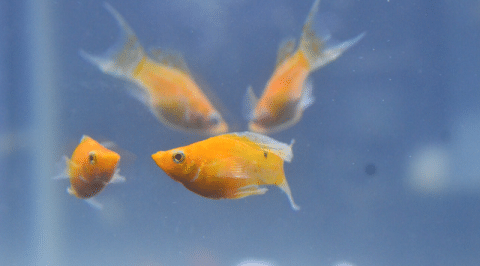
- Scientific Name: Poecilia sphenops, P. latipinna, etc.
- Care Level: Intermediate
- Temperament: Peaceful – semi-aggressive
- Swimming Level: Middle
- Origin: North & South America
- Adult Size: 3 – 5 inches
- Minimum Tank Size: 30 gallons
- Water Temperature: 70 – 82°F
- pH: 7 – 8.5
Mollies are another great beginner fish for freshwater aquariums. There are a few different species, although the balloon and sailfin mollies tend to be the most popular choices.
Molly fish are from the same family as the guppy fish, so they’re also really easy to breed in the home aquarium. These interesting fish can even live in saltwater, but they do great in freshwater tanks of 30 gallons or more.
7. Swordtails

- Scientific Name: Xiphophorus hellerii
- Care Level: Easy
- Temperament: Peaceful
- Swimming Level: All levels
- Origin: Central America
- Adult Size: 4 – 6 inches
- Minimum Tank Size: 20 gallons
- Water Temperature: 61 – 82°F
- pH: 7 – 8
Swordtails are livebearers, just like guppies and molly fish. The male fish are identified by their amazing sword-like tails, but the female fish can also be very colorful.
Swordtails come in some awesome colors, including bright orange and even koi patterns. They are very easy to breed and get along peacefully with many other tropical fish species.
8. Platy
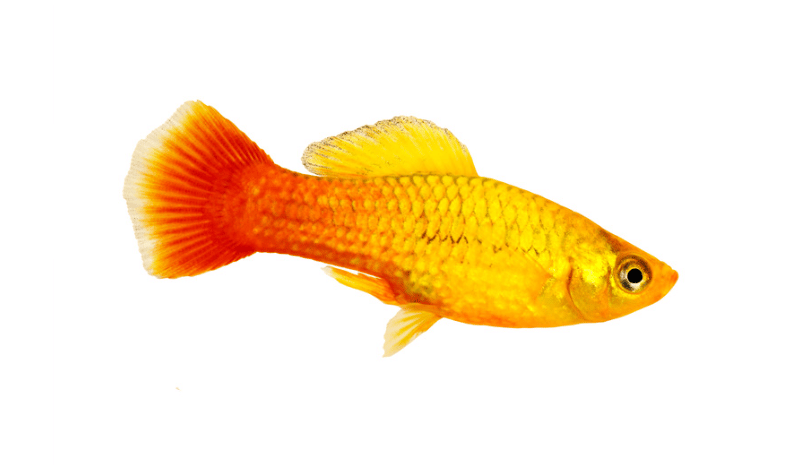
- Scientific Name: Xiphophorus maculatus
- Care Level: Easy
- Temperament: Peaceful
- Swimming Level: All levels
- Origin: Mexico & Central America
- Adult Size: 2 -3 inches
- Minimum Tank Size: 15 gallons
- Water Temperature: 68 – 79°F
- pH: 7- 8.2
Platy fish are very similar to swordtails but do not have the same long tail. They are also a little smaller which means you can keep them in a freshwater tank of just 15 gallons or so.
Platy fish are available in many different breeds like the sunset and the wagtail platy. Many of them have an orange body that adds a bold splash of color to any freshwater aquarium.
9. African Cichlids

- Scientific Name: Aulonocara, Pseudotropheus, Haplochromis, etc.
- Care Level: Intermediate – Advanced
- Temperament: Semi-aggressive – aggressive
- Swimming Level: Middle/ Bottom
- Origin: African Rift Lakes
- Adult Size: 2 – 15 inches
- Minimum Tank Size: 55 gallons
- Water Temperature: 74 – 82°F
- pH: 7.8 – 8.4
African cichlids are some of the most colorful freshwater fish in the hobby. There is an amazing variety of different species in this group, but they generally require specialized care and are not suitable for most tropical community tanks.
African cichlids tend to be aggressive and territorial. They need a fairly large aquarium and high-pH water to thrive. Don’t let that put you off though, these are the perfect fish for more experienced fishkeepers who want a show-stopping aquarium full of life and activity!
10. New World Cichlids

- Scientific Name: Astronotus, Amatitlania, Rocio, etc.
- Care Level: Easy – Advanced
- Temperament: Semi-aggressive – Aggressive
- Swimming Level: Bottom and middle
- Origin: North & South America
- Adult Size: 6 – 12 + inches
- Minimum Tank Size: 30 gallons
- Water Temperature:75 – 80°F
- pH: 6.5 – 8
The New World cichlids are similar to African cichlids but are native to America. They range from small to very large and can be peaceful or highly aggressive fish depending on the species. Jack Dempsey fish, Firemouths, Oscars, and convict cichlids are all popular examples of new world cichlids.
Whether you are just starting out, or you’ve been keeping freshwater fish for a lifetime, there is a New World cichlid for you. As always, just be sure to research the specific needs of any fish before taking it home.
11. Dwarf Cichlids
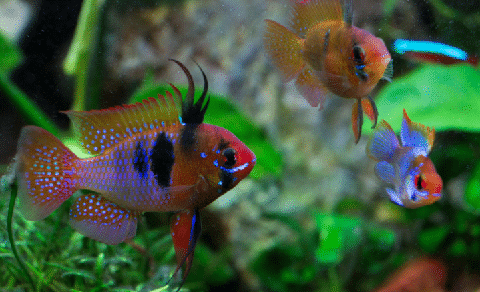
- Scientific Name: Apistogramma, Mikrogeophagus, etc.
- Care Level: Easy to Advanced
- Temperament: Peaceful- semi-aggressive
- Swimming Level: Bottom
- Origin: Africa & South America
- Adult Size: 2.5 + inches
- Minimum Tank Size: 10+ gallons
- Water Temperature: 72 – 86°F
- pH: 5 – 8 depending on the species
Dwarf cichlids are the little cousins of the African and New World cichlids. These small, colorful freshwater fish tend to be relatively peaceful and can make great additions to many community aquariums.
The dwarf cockatoo cichlid, German blue ram, Apistogrammas, and the Kribensis cichlid are all great examples of dwarf cichlids.
12. Arowana
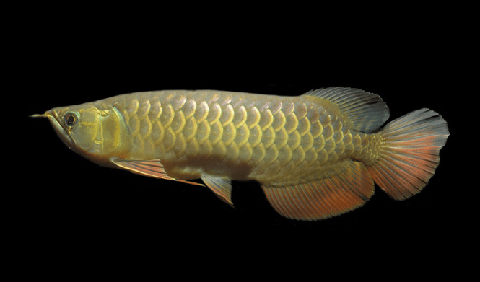
- Scientific Name: Scleropages formosus
- Care Level: Advanced
- Temperament: Aggressive
- Swimming Level: Top
- Origin: South America
- Adult Size: 3 feet
- Minimum Tank Size: 250 gallons
- Water Temperature: 75 – 82°F
- pH: 5 – 7.5
The Arowana is a large and impressive freshwater fish that is only suitable for expert fish keepers with plenty of space for a huge aquarium. These beautiful silvery fish can grow to 3 feet in length and need an aquarium of at least 250 gallons when fully grown.
Arowana fish are carnivores, so they need a high-protein diet such as feeder fish, insects, and other meaty foods. They can do well in community tanks if kept with other more aggressive fish that are too big to swallow.
13. Tetras
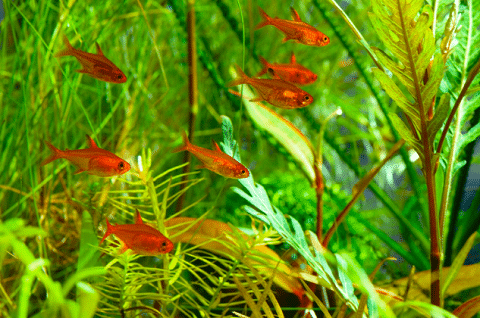
- Scientific Name: Paracheirodon, Hyphessobrycon, Gymnocorymbus, etc.
- Care Level: Easy
- Temperament: Peaceful/ Semi-aggressive
- Swimming Level: Middle
- Origin: South America, Africa
- Adult Size: 0.75 – 3 inches
- Minimum Tank Size: 15 gallons
- Water Temperature: 75 – 80°F
- pH: 6.8 – 7.8
Tetras are the perfect choice for a tropical community aquarium. These small, schooling fish come in every color of the rainbow and are generally very easy to care for. Most tetras come from South America1, but some species, like the Congo tetra, are from Africa.
Choose colorful species like the ember and cardinal tetra to brighten up your aquarium, or go for serpae or black phantoms if you want fish with a more interesting shape.
14. Barb
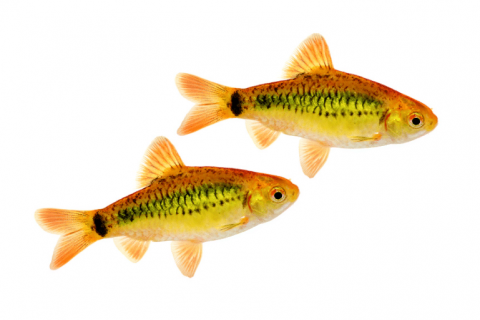
- Scientific Name: Barbus, Puntius etc.
- Care Level: Easy – Intermediate
- Temperament: Peaceful – Semi-aggressive
- Swimming Level: Middle
- Origin: Asia
- Adult Size: 2 – 13 inches
- Minimum Tank Size: 15 – 100 + gallons
- Water Temperature: 75 – 80°F
- pH: 6.8 – 7.8
Barbs are another great option for fish keepers who want active, schooling fish for a community aquarium. Most species stay between 2 and 3 inches, but some like the tinfoil barb can grow very large.
Most barbs are very peaceful fish, but the tiger barb has earned a reputation for being a fin nipper. Barbs are schooling fish that should be kept in groups of 6 or more.
15. Rasboras
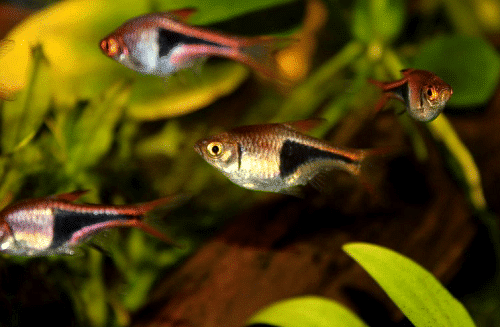
- Scientific Name: Trigonostigma, Celestichthys, Boraras etc.
- Care Level: Easy – Intermediate
- Temperament: Peaceful
- Swimming Level: Middle
- Origin: Asia
- Adult Size: 0.75 – 1.75 inches
- Minimum Tank Size: 5 – 20 gallons
- Water Temperature:68 – 82°F
- pH: 5 – 8, depending on the species
Rasboras are nano (very small) fish from the same family as barbs and goldfish. These peaceful schooling fish are perfect for a tropical community in a heavily planted aquarium where they tend to hang out in the middle level.
These social fish should not be kept in groups of less than 5, so make sure you pick up a nice big school of the same species to see them behaving confidently.
16. Gouramis

- Scientific Name: Trichogaster, Trichopsis, Trichopodus etc.
- Care Level: Easy – Intermediate
- Temperament: Peaceful/ Semi-aggressive
- Swimming Level: Bottom/ Middle
- Origin: Asia
- Adult Size: 1.5 – 28 inches
- Minimum Tank Size: 10 gallons
- Water Temperature: 68-86°F (depending on species)
- pH: 5.5 – 8
Gouramis are wonderful aquarium fish that come in many different shapes and sizes. Nano species like the sparkling gourami can be kept in tanks as small as 10 gallons, while the impressive giant gourami needs about 250 gallons when it is fully grown.
Most gouramis are very peaceful fish that do best when kept in a pair. They are a great choice for a heavily planted tank with other small community fish.
17. Killifish
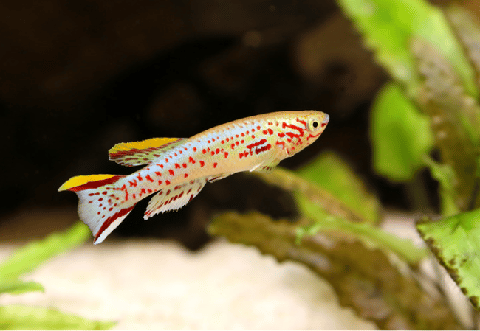
- Scientific Name: Aplocheilus, Jordanella, Fundulopanchax, etc.
- Care Level: Easy – Advanced
- Temperament: Peaceful – Aggressive
- Swimming Level: All levels
- Origin: Africa, Asia, America
- Adult Size: 1.5 – 5.5 inches
- Minimum Tank Size: 5 – 20 gallons
- Water Temperature: 68 – 75°F
- pH: 6 – 7
Killifish are great nano fish that come in some amazing colors. These fish are not very common in the aquarium trade but they are a great choice for fishkeepers looking for something a little different.
Some killifish species are very shortlived because they live in temporary pools that evaporate in the dry season. Others can live for multiple years, however.
18. Danios
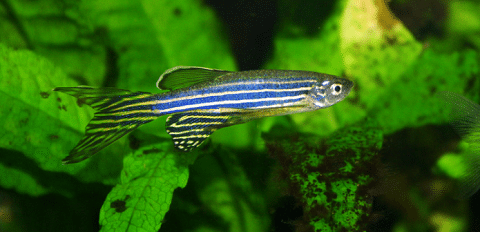
- Scientific Name: Celestichthys, Danio, Brachydanio, etc.
- Care Level: Easy – intermediate
- Temperament: Peaceful
- Swimming Level: Upper levels
- Origin: Asia
- Adult Size: 1 – 4 inches
- Minimum Tank Size: 10 gallons
- Water Temperature: 65 – 75°F
- pH: 7 – 7.8
Danios are small Asian schooling fish that are great for community tanks. Some, like zebra danios, are very hardy and make an ideal choice for beginner fish keepers.
Danios tend to be very active swimmers, and they can add a lot of movement to your aquarium. They are very social fish, so they need to be kept in a school of at least 6 of their own kind.
19. Rainbow
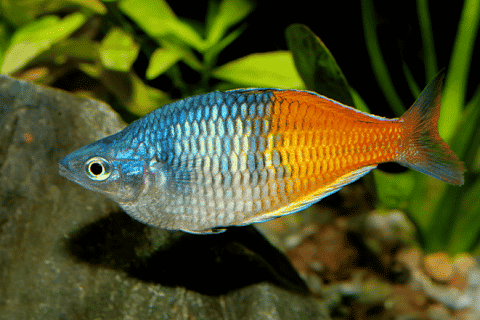
- Scientific Name: Marosatherina, Melanotaenia, Pseudomugil etc.
- Care Level: Easy
- Temperament: Peaceful
- Swimming Level: Middle/Top
- Origin: Australia, Indonesia
- Adult Size: 2 – 6 inches
- Minimum Tank Size: 15 – 55 gallons
- Water Temperature: 74 – 82°F
- pH: 7 – 8
Rainbowfish are beautiful freshwater fish from Australia and Southeast Asia. They get their name from their awesome colors, which are especially bright when the fish are spawning. They are active fish that need a fairly large aquarium.
Rainbowfish have a very peaceful nature and fit in well with most other community fish. They are social creatures, however, so keep them in a shoal of 6 or more.
20. Freshwater Puffers

- Scientific Name: Carinotetraodon, Tetraodon etc.
- Care Level: Intermediate – Advanced
- Temperament: Semi-aggressive/ Aggressive
- Swimming Level: All levels
- Origin: South America, Asia, Africa
- Adult Size: 1 – 24 inches
- Minimum Tank Size: 5 – 125 + gallons
- Water Temperature: 74 – 78°F
- pH: 7 – 7.6
Freshwater puffers are some of the most fascinating fish in the aquarium hobby. These funny-looking fish are known for their ability to puff up into a ball when threatened by a predator.
Freshwater pufferfish range in size from nano species like the 1-inch dwarf pea puffer, all the way to 2-foot giants like the Mbu puffer.
Pufferfish are not very active, so the smallest species can be kept in tanks of just 5 gallons or so. Puffers have very sharp parrot-like teeth, however, and they can be aggressive toward other fish. These fish usually work best in a species-only tank.
21. Hatchetfish
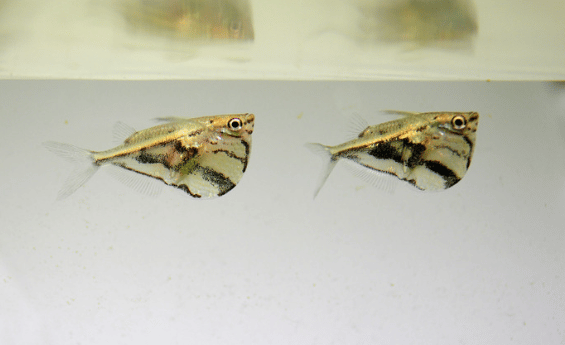
- Scientific Name: Carnegiella, Gasteropelecus, etc.
- Care Level: Intermediate
- Temperament: Peaceful
- Swimming Level: Top
- Origin: Central & South America
- Adult Size: 1.5 – 2.5 inches
- Minimum Tank Size: 20 gallons
- Water Temperature: 75 – 80°F
- pH: 6 – 7
Hatchetfish are unusual, flattened nano fish that spend their time near the surface of the aquarium. These schooling fish have long pectoral fins and huge muscles in their chests that they use to leap out of the water to escape their predators.
Hatchetfish are wonderful freshwater fish for tropical community tanks. However, their acrobatic abilities mean they need to be kept in a tank with a tight fighting lid and great care is necessary when performing aquarium maintenance.
22. Freshwater Sharks
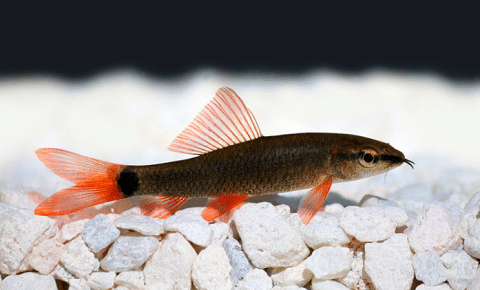
- Scientific Name: Epalzeorhynchos, Balantiocheilos, etc.
- Care Level: Easy – Advanced
- Temperament: Peaceful – Aggressive
- Swimming Level: Bottom/ Middle
- Origin: Southeast Asia & South America
- Adult Size: 5 inches – 3 feet +
- Minimum Tank Size: 65 – 150 + gallons
- Water Temperature: 74 – 80°F
- pH: 6.8 – 8
Freshwater sharks are not true sharks, but they do have a very similar shape. These medium to large aquarium fish are available in some bold colors, including black, red, and silver.
The rainbow shark is probably the most popular species. This fish has bright red fins and a potentially aggressive nature. Rainbow sharks are also available in some amazing neon colors for fish keepers who want an awesome display fish.
23. Freshwater Eels
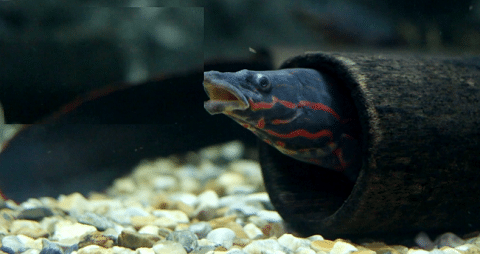
- Scientific Name: Mastacembelus, Macrognathus, etc.
- Care Level: Easy- Advanced
- Temperament: Peaceful – Aggressive
- Swimming Level: Bottom
- Origin: Southeast Asia, Africa
- Adult Size: 8 inches to several feet
- Minimum Tank Size: 30 gallons
- Water Temperature: 72 – 82°F
- pH: 6 – 7
Freshwater eels are probably not the first fish that comes to mind when planning a fish tank, but there are many amazing types that you can keep in your aquarium. Some species like the tire-track eel and fire eel even have beautiful patterns and colors.
These fish need a secure lid to keep them from escaping. They are generally shy and nocturnal, so make sure you provide plenty of hiding spaces and keep the lights fairly dim if you want to see them active.
24. Freshwater Gobies
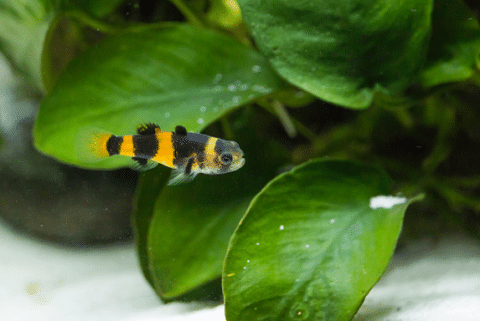
- Scientific Name: Stiphodon, Brachygobius, Gobioides, etc.
- Care Level: Easy- Intermediate
- Temperament: Peaceful – Aggressive
- Swimming Level: Bottom
- Origin: Africa, Asia, Americas
- Adult Size: 2 – 15 inches
- Minimum Tank Size: 10 – 50+ gallons
- Water Temperature: 72 – 84°F
- pH: 7.5 – 8.5
Freshwater gobies come in a range of shapes and sizes. These fish have loads of attitude and interesting behavior which makes them fascinating creatures to observe in the home aquarium.
They range from specialist algae eaters to carnivores and can be peaceful community fish or aggressive fish eaters. Many of the freshwater gobies sold in the hobby actually need brackish water to thrive, so make sure you research these fish carefully before adding them to your tank.
25. Cory Catfish

- Scientific Name: Corydoras spp.
- Care Level: Easy
- Temperament: Peaceful
- Swimming Level: Bottom/ Middle
- Origin: South America
- Adult Size: 1 – 4 inches
- Minimum Tank Size: 15 – 3o gallons
- Water Temperature: 74 – 80°F
- pH: 7 – 8
Cory catfish are an excellent choice for beginner fish keepers. These small, bottom-dwelling catfish deserve a place in any peaceful community aquarium. They get along with most other fish so they are ideal for a freshwater community tank.
Corydoras catfish stay small and love to hang out at the bottom of the tank, digging through the substrate to look for food. They are schooling fish, so keep them in a group of 4 or more to see them at their confident best.
26. Loaches

- Scientific Name: Pangio, Botia, Sewellia, etc.
- Care Level: Easy – Intermediate
- Temperament: Peaceful
- Swimming Level: Bottom
- Origin: Asia
- Adult Size: 1- 12 inches
- Minimum Tank Size: 20+ gallons
- Water Temperature: 64 – 86°F (depending on species)
- pH: 6 – 7.5
Loaches are another favorite fish in the aquarium hobby. These goofy bottom-dwellers are pretty diverse, ranging from the small, eel-like kuhli loach to the large, shark-shaped clown loach. Loaches make great clean-up fishes, and they tend to be very peaceful in community tanks.
Loaches are well-known for their snail-killing abilities, so this is one fish to avoid if you enjoy keeping inverts!
27. Plecos
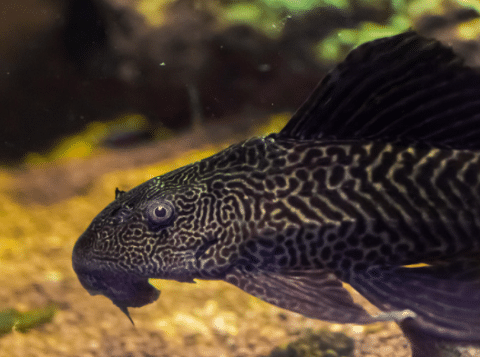
- Scientific Name: Ancistrus, Panaque, Hypostomus, etc.
- Care Level: Easy-Advanced
- Temperament: Peaceful – Semi-aggressive
- Swimming Level: Bottom
- Origin: South America
- Adult Size: 2 inches – 2 feet
- Minimum Tank Size: 30+ gallons
- Water Temperature: 74 – 80°F
- pH: 7 – 8
Plecos are also known as suckermouth catfish. These fish are built like tanks, with tough scales for armor and large shark-like fins. Most species have natural colors which they use for camouflage on the river bottom, although some have bold, striped and spotted markings.
There are over 500 varieties of plecos in the aquarium hobby, ranging from small and beginner-friendly to expert-only, so you can bet there’s a perfect pleco for you!
28. Catfish

- Scientific Name: Pimelodus, Synodontis, Kryptopterus, etc.
- Care Level: Easy – Advanced
- Temperament: Peaceful – Aggressive
- Swimming Level: Bottom/ Middle
- Origin: South America, Asia, Africa
- Adult Size: 2 inches – several feet
- Minimum Tank Size: 20+ gallons
- Water Temperature: 72 – 82°F
- pH: 6.5 – 7.5
There are over 3000 known freshwater catfish species in the world, and many of them make great aquarium subjects! These whiskered bottom dwellers come in many shapes and sizes, from 1-inch corydoras to man-sized predators from murky waters.
The larger catfish are usually carnivorous species that eat other fish. This means you need to be pretty careful about choosing smaller fish as tankmates, or you’ll start to notice them disappear!
Popular aquarium species include the synodontis and Pictus catfish, as well as the cories and plecos mentioned above in this post. Many of the catfish sold in aquarium stores grow way too big for most home aquariums, so make sure you research their adult size before taking them home.
29. Freshwater Stingrays

- Scientific Name: Potamotrygon spp.
- Care Level: Advanced
- Temperament: Peaceful – semi-aggressive
- Swimming Level: Bottom
- Origin: South America
- Adult Size: 1 foot +
- Minimum Tank Size: 200+ gallons
- Water Temperature: 75 – 82°F
- pH: 6.8 – 7.6
Freshwater stingrays are awesome pets for experienced fish keepers with plenty of space. These flat members of the shark family need an extra large tank or a shallow indoor pond to provide the space they need. Stingrays are potentially dangerous animals, although injuries are rare.
The smallest freshwater stingrays are about a foot across, but some species reach truly gigantic proportions! These fish also need excellent water quality and quality filtration, so they are best left to the experts.
30. Freshwater Shrimp
Freshwater aquarium shrimp are a great addition to small tanks and aquascapes. Peaceful, full of personality, and colorful. Many varieties are available.
- Scientific Name: Caridina, Neocaridina, etc.
- Care Level: Easy- Intermediate
- Temperament: Peaceful
- Swimming Level: Bottom
- Origin: Asia
- Adult Size: 1 – 2 inches
- Minimum Tank Size: 5 gallons
- Water Temperature: 64 – 76°F
- pH: 6.5-7.5
Ok, so freshwater shrimp are not technically fish, but they are still some of the coolest animals you can keep in a fish tank! These fascinating crustaceans come in all sorts of colors and breeds.
Freshwater shrimp do best in a tank with plenty of aquatic plants just like their natural habitat, and they can be kept with some small freshwater aquarium fish species. However, most fish will eat freshwater shrimp, so choose their tankmates carefully.
FAQs
What Is The Most Popular?
The goldfish is the most popular freshwater aquarium fish. These awesome cool-water fish have a rich history in the fish-keeping hobby, dating back centuries. Today they are as popular as ever and they come in a jaw-dropping variety of shapes, colors, and fin types.
Are There Tropical Freshwater?
Most freshwater aquarium fish are tropical species for good reason. The tropical regions of the world have the greatest diversity of fish, as well as the most exotic and colorful species.
What’s The Difference Between Both?
Tropical fish are the species that come from areas near the equator where it is always warm. There are tropical saltwater and freshwater fish. Tropical freshwater fish are very popular aquarium fish, they just need a heater to keep the water warm.
Which Is The Easiest To Take Care Of?
Guppies are probably the easiest fish to care for. These hardy fish do not have any special care requirements and they get along great with other peaceful community fish.
How Long Do They Live In A Home Aquarium?
Freshwater fish have different lifespans depending on their species and the quality of life you give them. Some African Killifish never live more than a year because they have evolved to complete their life cycle in temporary waterholes. Others, like the goldfish, can live for over 15 years with good care.
Final Thoughts
I know, choosing the perfect species for a freshwater fish aquarium can be tough. It’s always best to research and choose your fish before you start shopping though, rather than making any hasty decisions. I hope you find your next fish from this list, and if you didn’t, maybe a bucket list species for a future tank!
What is your favorite aquarium fish species? Comment below!
- About the Author
- Latest Posts
I’m thrilled that you found Aquarium Store Depot! Here you’ll find information on fish, aquariums, and all things aquatics related. I’m a hobbyist (being doing this since I was 11) and here to help other hobbyists thrive with their aquariums! I adhere to a high quality Editorial Process and Review products with real life field usage and practical analysis.


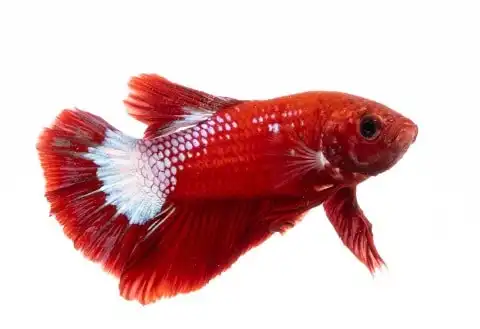





i meant his name is [KING BLUE 🔵👑]
i have a male 3spot blue gourami named KING🔵👑. he is the king of the tank I will add another female opaline gourami soon and some Malaysian Rasboras and 1 single male Republican🚩 festivum cichlid.